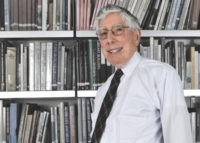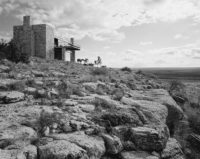Diane Lewis died early May 2 in Manhattan after a long illness. Born in 1951 in New York City, Lewis first studied art at New York’s Cooper Union for the Advancement of Science and Art, although she then received her B.Arch from that institution's Irwin S. Chanin School of Architecture in 1976, where the legendary poetic architect, John Hejduk, her long-time mentor, was its dean. Lewis taught there from 1982 to the present, the first female architect to be named to the full-time faculty. She opened her office, Diane Lewis Architects, in 1983.
A forceful and influential professor as well as a committed and sensitive practitioner, Lewis had decided early to be an architect. Growing up, she once said, she became aware of all the new architecture going up in New York because her father was the editor of the Herald Tribune’s real estate section. Her knowledge of architecture deepened when she went off to Europe as a recipient of the Rome prize of the American Academy in Rome in 1976-77, one of the youngest to receive this prestigious award. Since the early ‘70s, Jacques Herzog recalls, “Diane has been in my life. She was very smart, confusingly crazy, and wonderfully funny—an unlikely and inspiring mix of talents and weaknesses, like nobody else!”
Lewis steadfastly believed, as she once put it, “The moral rules of a civilization are the springboard for being an architect.” Teaching helped impart her belief system: Lewis was a visiting professor at Harvard’s Graduate School of Design; Yale’s Graduate School of Architecture; the University of Toronto; the University of Edinburgh; London’s Architectural Association, and the Technical University of Berlin. “Her generous intellect always made you feel as if you came away from her a smarter person,” says Merrill Elam. “Lewis loved architecture, students, the city and being on the planet. Her energy and appetite for life were enormous. She taught students things about architecture they didn’t know pertained to architecture. She knew that in using the hand and the head lay the possibility for making architecture.”
Lewis brought the same belief system to practice. As Richard Meier said upon the news of her death, “At the center of her pursuit of a moral ideal for the profession of architecture is a bold willingness to interrogate the most fundamental elements of history and civilization.” Lewis had joined the office of Richard Meier when she returned from Rome (1977-78), and then worked for I. M. Pei & Partners as a senior designer and curtain wall designer from 1978-83. Her own office concentrated on schools, galleries and houses, including an apartment for Brooks Adams and Lisa Liebmann (2012); a loft for architectural theorists and critics Mark Wigley and Beatriz Colomina (2006); the Annenberg Penthouse Residence and Art Collection in New York City (1993-94); and the Paul Kasmin Gallery (1986) among other projects. Lewis told Record in 2006, “I attract a special client—one with a particularly intellectual and artistic bent.”
In 2008, Lewis received a National Design Award from the Cooper-Hewitt, Smithsonian Design Museum, in recognition of her contribution to the discipline of architecture. Asked about being a sole female practitioner, Lewis once said, “I’m an eroticist, not a feminist. The advantage of being a woman is that women are more and more willing to challenge the way architecture is produced. The students I see now are transformed. So the way architecture is going to be made will change.”
In recent days, a group of international architects—including Tod Williams, Billie Tsien, Harry Cobb, Richard Meier, David Childs, Jacques Herzog, Pierre de Meuron, Frank Gehry, James Polshek, Annabelle Selldorf, Denise Scott Brown, Robert Venturi, Toshiko Mori, Barry Bergdoll, Calvin Tsao, Gina Pollara, Moshen Mostafavi, Wendy Evans Joseph, Roger Duffy and many others—signed a letter of support for Lewis to be named Cooper Union Professor, a distinction initiated to celebrate academic excellence and commitment to the school. The day before her death, Diane Lewis received the President's Citation from Cooper Union's president, Laura Sparks.
RESPONSE: Architects Remember Diane Lewis
Updated May 8, 2017
From Tod Williams: “Diane was an original, a passionate architect and teacher, carrying on the unique legacy of Cooper Union and of her mentor, John Hedjuk.”
From Barry Bergdoll: “Diane Lewis was literally possessed by a passion for architecture and the ethical city. She was at once uncompromising and witty, unforgiving and humane, critical and perennially optimistic. She fought for the role of architecture and for the urban realm even as she battled unflinchingly with her final illness. She is a real loss for the city and for architectural education.”
From Carl Andre: “Her work makes a difference. It gets the job done with great economy and elegance.”
From Wendy Evans Joseph: “Wallace Stevens said ‘Things as they are Are changed upon the blue guitar.’ Being with Diane I had the perception that what I thought I knew was coming to me in a totally different way. Diane floated from architecture to history to art to film reinterpreting each creative medium to make a position in design that challenged my thinking. I’ll miss her challenges.”
From Peter Schubert: “Art and architecture for Diane was an ongoing existential narrative, but when she paraphrased Pirandello, saying ‘History need not be plausible, fiction must be,’ I knew how she paints.”
From Paul Aferiat: “I was one of the lucky few to be with her at Richard Meier’s (small) office. She was a brilliant, funny, passionate, she was a completely unforgettable New York character.
I was so, so pleased to read that she lived to receive the great honor from Cooper Union, as well as to see the legacy of student work documented in her most recent publication Open City Existential Urbanity: The Architecture of the City Studio 2001-2014 (2015).
Richard’s comment for the obituary was truly touching. She idolized him and would have been profoundly moved by it. They do not create professors like her anymore. Cooper Union and her students were truly blessed. She will be sorely missed.”
From Jayne Merkel: “Diane certainly was one of a kind, one of the smartest people I have ever known, though not the easiest. But she had a really very good heart.”





Post a comment to this article
Report Abusive Comment